Last Updated on August 8, 2024 by Roslin Dwivedi
Tucked in the middle of the lush greenery of Tampaksiring village in Bali, Tirta Empul Temple stood centuries of spiritual devotion and cultural richness. The temple is mostly popular among tourists for its water purification ceremony. It’s amusing how the holy spring helps you cleanse your souls and body. Thankfully the temple welcomes locals and tourists both offering Balinese healing experience.
The water purifying ceremonies at the enchanted Tirta Empul Temple, also known as “melukat” or “penglukatan,” were quite soul-stirring during our stay. This ceremony has enormous spiritual significance for the local community and is an essential component of Balinese Hinduism.
Its roots intertwined with the island’s deep-seated Hindu traditions. Established in the tenth century, the temple has experienced the ups and downs of time, emerging as a major hub for pilgrims in search of spiritual purification and rejuvenation.
locals say that the holy springs running through the grounds have cleansing qualities that links between the physical and the divine.
It may take you around 2-3 hours to be at the temple if you are participating in the water rituals. After finishing the visit to the temple, you may also do some Bali souvenir shopping from the market that opens outside the temple. Do some bargaining to get a better deal.
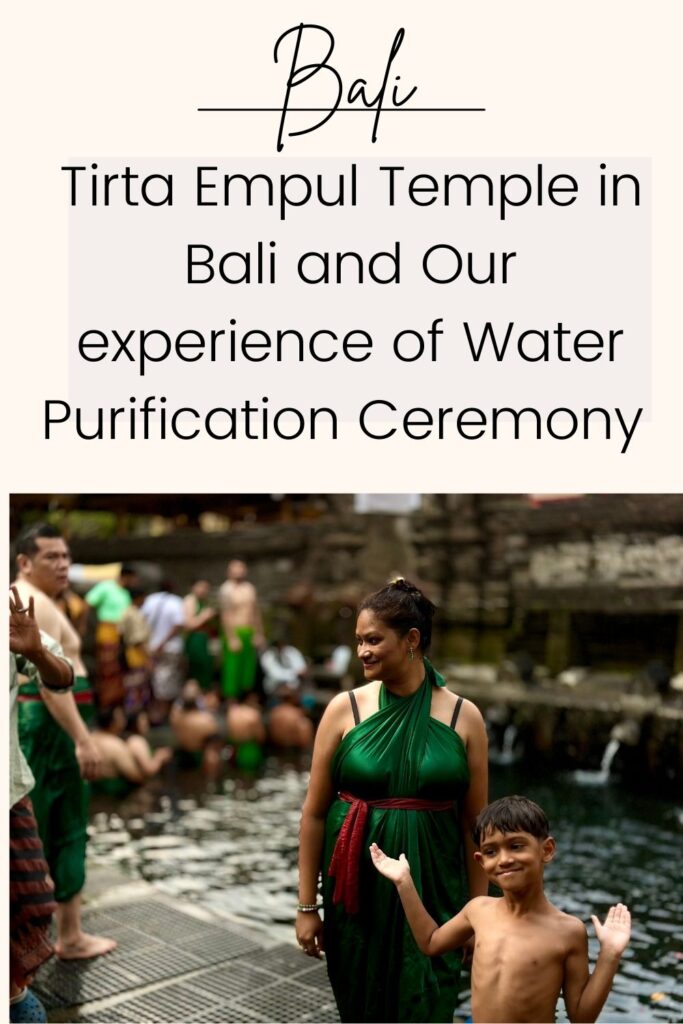
Architectural Beauty
Tirta Empul Temple is an architectural masterpiece of ancient Balinese design with intricate details that captivate the eye and stir the soul.
As you swipe your tickets and enter the temple you will come out to an open courtyard, filled with greenery around and the most distinctive features of Tirta Empul, the pristine 11-tiered meru tower, dedicated to the God Indra.
This resplendent layered towering structure is a rare sight in Balinese temples and adds a unique vertical dimension to the architectural ensemble.
As you walk ahead you will reach the place where you can get a sarong to enter the temple. You enter the traditional door of Bali and appear to an open courtyard again that has adorable stone reliefs and sculptures with a pond filled with big healthy coy fishes. There you will also find some souvenir shops and snacks shops. Crossing the pond area you will enter another section of the temple.
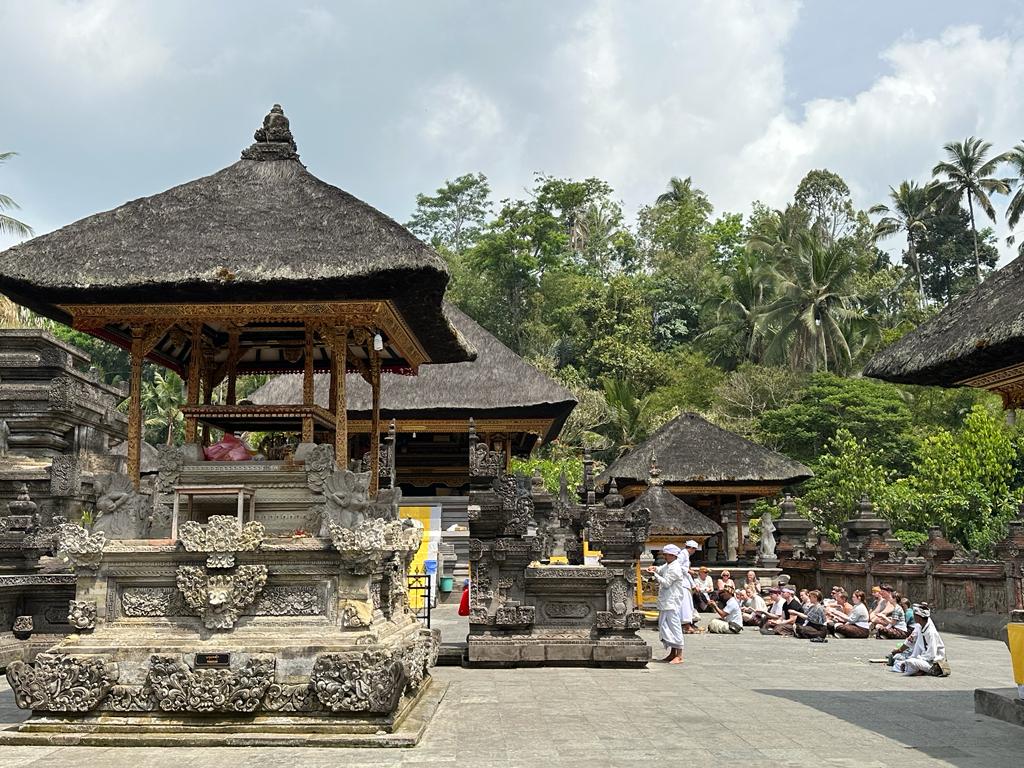
The towering Candi Bentar split gateway, adorned with ornate stone carvings that narrate tales of Hindu mythology. These carvings depict celestial beings, epic battles, and intricate floral motifs making you visual tapestry of Balinese spirituality.
The temple has a series of courtyards, each holding significance in the ritual processions that take place here.
Moving further into the complex, you’ll encounter a series of shrines, pavilions.
The central courtyard features three pools representing past life, present life and future life. These pools are fed by sacred springs, where devotees come to partake in the transformative water purification ceremony. There’s a lot more to this temple, you can witness the spring water appear from the ground before syphoned into the pools. This place where the fresh spring water appears, protected as a pond where you can also observe a black Eel.
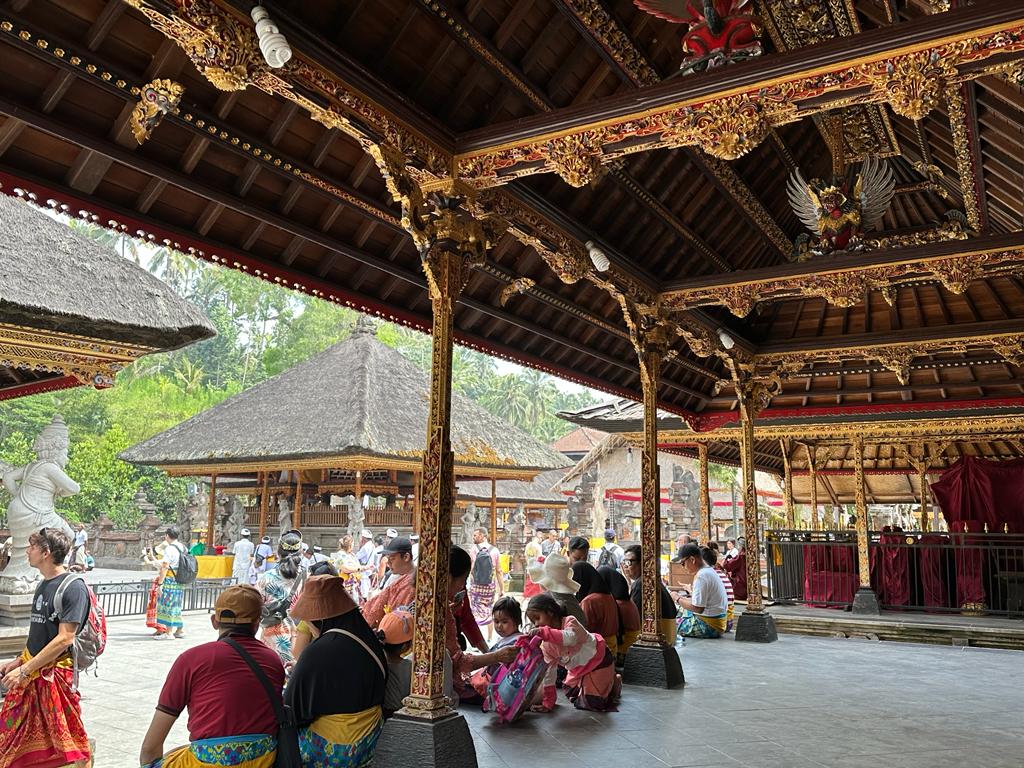
Individual temple buildings known as Asagan, used on a daily basis to store magnificent handmade offerings as well as musical instruments and barong costumes for larger rituals. You will observe ladies, men, and adorable children dressed in traditional Balinese attire, which is essential to enter the central temple area for prayer. This area is restricted for tourists and is open only for the locals for their prayers and offerings.
The Legend of Tirta Empul
Legend has it that Tirta Empul Temple, rooted in a tale of divine intervention and the quest for immortality. According to Balinese folklore, there once lived a powerful king named Mayadenawa, known for his formidable magical abilities. Mayadenawa, however, harbored a deep-seated arrogance and sought to usurp the natural order by declaring himself a god.
This hubris infuriated the true gods, who sent the strong god Indra to topple Mayadenawa’s tyranny.
While fighting Mayadenawa, Lord Indra launched a storm of arrows and each of them impacted the earth with extraordinary force. As the story goes it’s a belief that the miraculous spring emerged precisely at the spot where Indra’s arrow struck. And that emerged several holy springs with healing and purifying properties.
In reverence to this legend, Tirta Empul Temple, established for those who are seeking spiritual purification and renewal. The waters of the spring are believed to carry the divine blessings and healing energies bestowed by the gods themselves.
There’s a chance this post contains affiliate links. I may receive a small commission (at no extra cost to you) that goes directly towards maintaining my website!
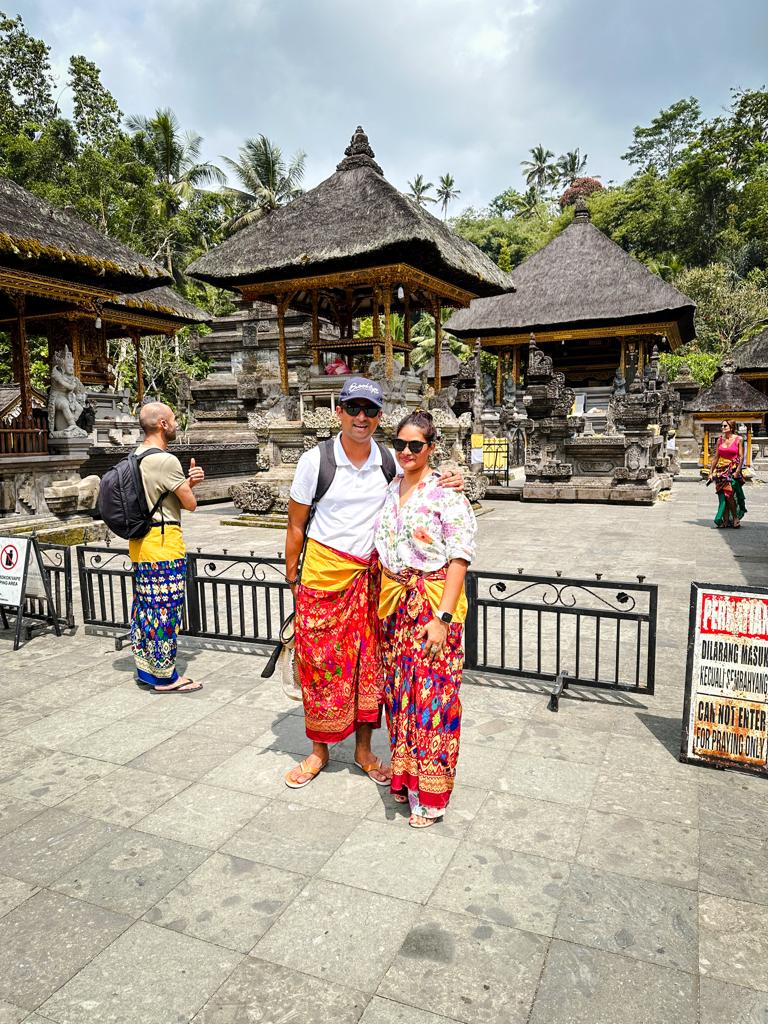
Water Purification Ceremony our experience
The water purification ceremony, known as “melukat” or “penglukatan,” is a sacred ritual performed at Tirta Empul Temple. It is a spiritual practice followed by Balinese Hinduism, symbolizing the cleansing of the body, mind, and soul. Here is how the ceremony is conducted:
- Before entering the sacred waters, you better prepare your heart and mind. Offer prayers and set your intentions for the purification process.
- You need to wear a sarong, a traditional Balinese cloth, which is symbolic of respect and humility. This attire signifies a conscious effort to approach the ceremony with reverence. You will get the sarong at the place where all the lockers are. Each sarong costs 10,000 IDR and if you need a locker, it will cost 15,000 IDR. You then change and wear the sarong at the locker area. Kids must also wear a sarong that costs the same as adults.
- After changing to Sarong, you can step into the central courtyard where a series of pools are fed by the temple’s sacred springs.
- If there is a line you follow the line if not then start the prayer from 2nd spring in the first rectangular pool and keep going until the last one. Except the last 2. As mentioned before.
- The first step involves immersing oneself in the water, allowing it to flow over the body. This initial bath is considered a physical cleansing, washing away impurities and negative energies.
- During each immersion, you recite prayers and mantras, expressing gratitude, seeking blessings, and invoking the divine. These sacred utterances serve to deepen the spiritual connection and focus the mind on the ritual’s purpose.
- You have to move through a series of additional baths, each with its own significance. Some may focus on specific aspects of purification, such as emotional healing or spiritual transformation.
- After the ritual baths, you may make offerings at the temple’s altars, expressing gratitude for the purification process and seeking continued blessings from the divine.
- In some cases, people may also bring personal items such as clothing or jewelry to be immersed in the holy water, believing that this further imbues them with the purifying energies.
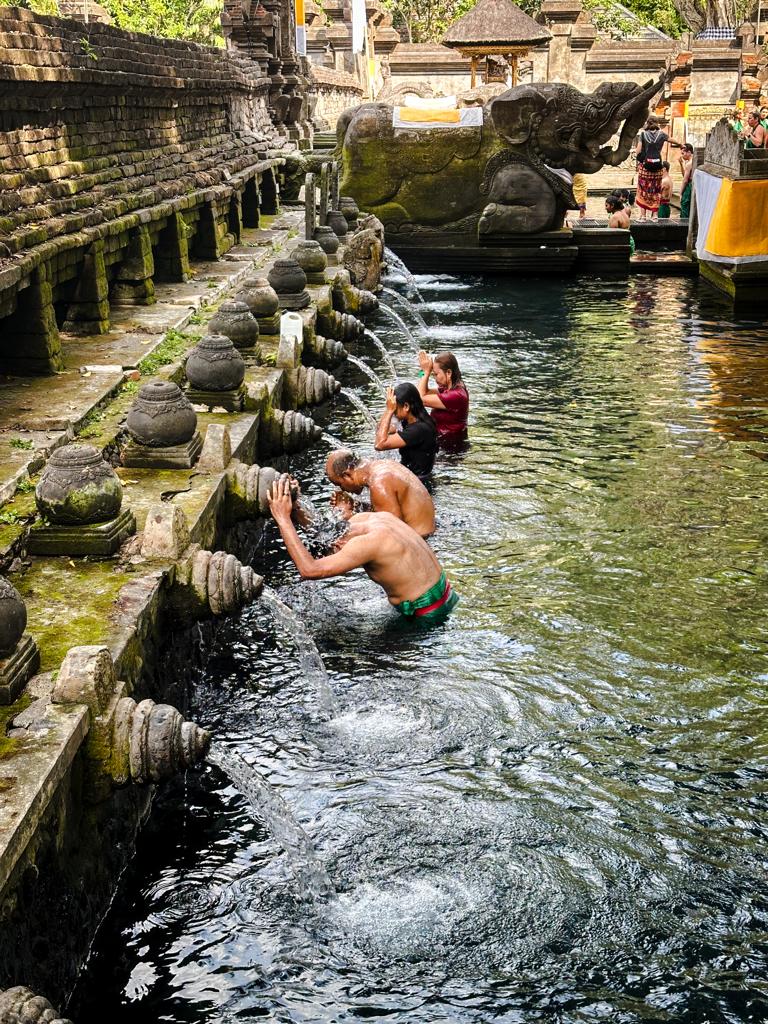
The significance of the water purification ceremony:
- The ritual baths symbolize the cleansing of impurities, both physical and spiritual, and the opportunity for a fresh start.
- The use of natural spring water reinforces the connection between humans and the natural world, emphasizing the sanctity of the environment.
- The process is seen as a form of spiritual rebirth, aligning participants with higher states of consciousness and inner peace.
Spiritual Significance of the water purification ceremony at Tirta Empul Temple
The water purification ceremony at Tirta Empul Temple holds profound spiritual significance for the Balinese. They deeply believe in the inherent purity and holiness of water, particularly from natural springs.
Immersing in the temple’s holy springs becomes a transformative experience, purifying the body, mind, and soul. Participants metaphorically shed their past selves, emerging with renewed purpose, clarity, and spiritual vitality. Balinese believed to carry the blessings and energies of the god Indra, and gives a connection to higher states of consciousness and transcendental wisdom.
Purifying the physical vessel is a preparation to receive divine blessings, fostering equilibrium in both inner and outer realms. The water purification ceremony also serves as a means to communicate with ancestors and deities, honoring those who came before and seeking their guidance and blessings in the present moment.
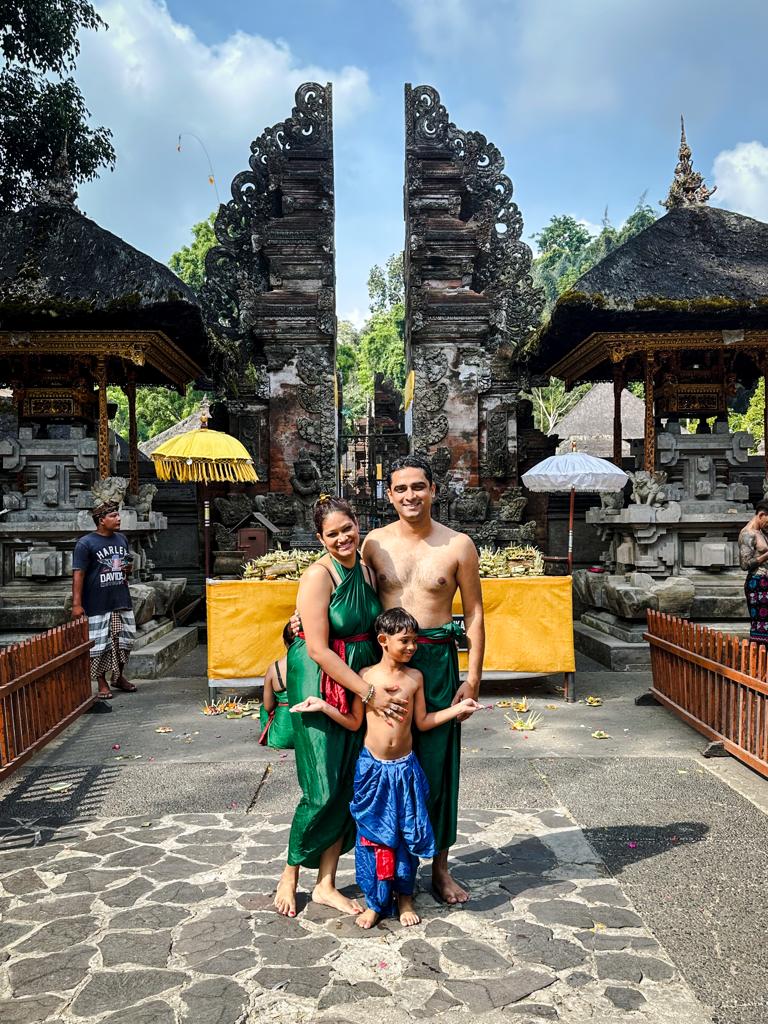
Our Participation in the Ceremony
The first rectangular pool has 13 fountains that are for cleansing the chakras, where two at the end are only for bathing when someone is dead in the family. Then there are 2 small pools where you continue your purification and bathe under 2 fountains in the first small pool and only 1 from the last pool. These pools reflect different emotions that humans must control, such as jealousy. You must place the crown of your head beneath each fountain and say your prayers.
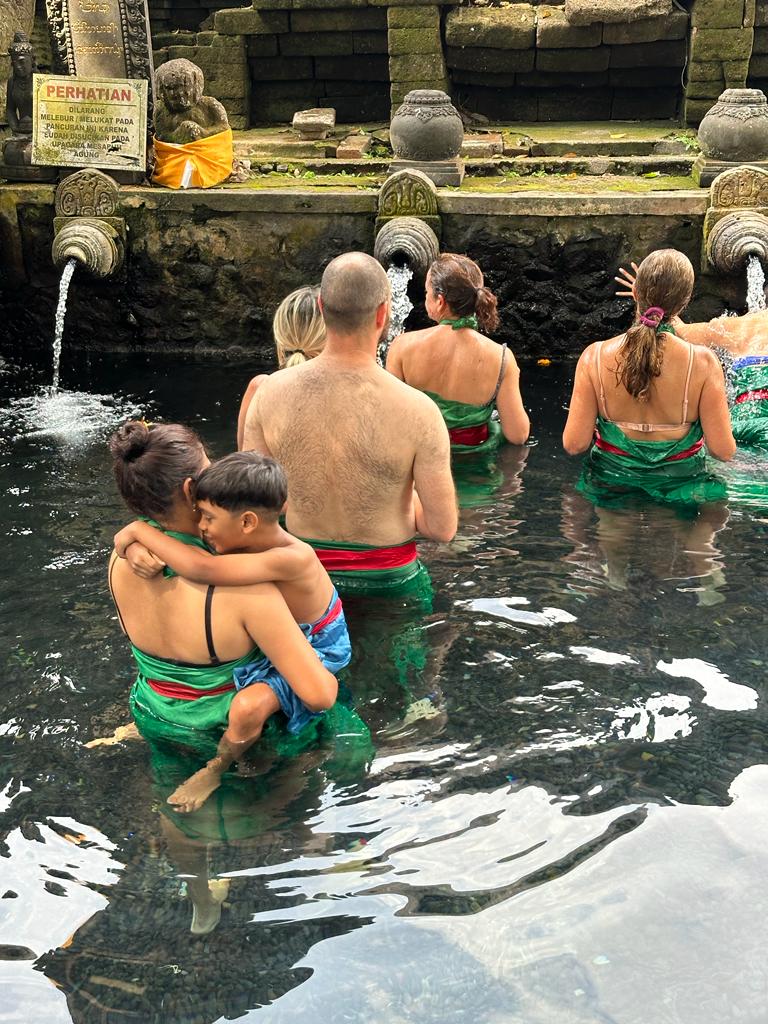
For us, my husband and I took rounds. First I went for the water purification with my son, so my husband could take some pictures of the ceremony.
Clad in the traditional sarong, my son and I approached the first pool with a mixture of curiosity and respect, fully aware of the ancient ritual I was about to partake in.
Stepping into the sacred waters of Tirta Empul Temple was a humbling experience. The water was very cold but its cool touch against my skin sent shivers down my spine awakening a sense of reverence and anticipation. Holding my son in my arms I submerged ourselves, the sensation of the cold water enveloping us was both invigorating and soothing. For my son also it was fun because you know how much kids love swimming pool and playing in the water.
But we followed the rules and decorum by not making the place a swimming pool but a place of prayers.
With every spring shower carried a weightless energy, gently washing away the layers of everyday life. The rhythmic sound of flowing water created a tranquil atmosphere while I prayed on behalf of our son and me.
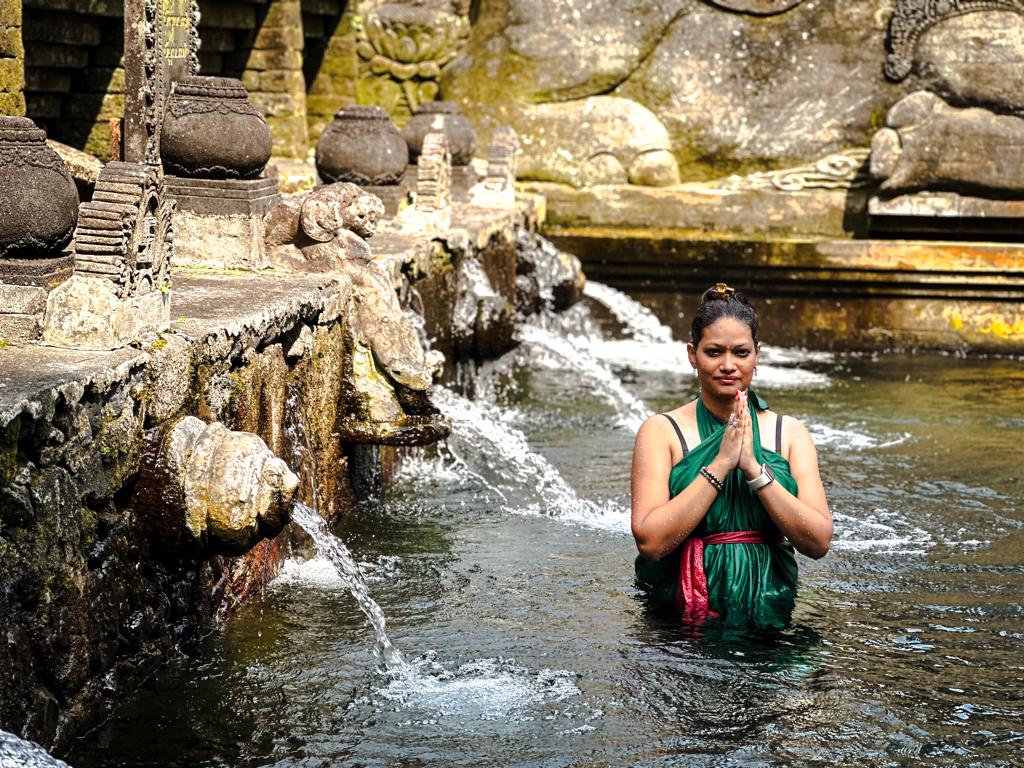
With each subsequent immersion, I felt a subtle shift within me. It was as if the waters were working their way through by dissolving tensions, worries, and doubts at the moment.
After my final pool, I felt lightness within myself. The experience left an indelible mark on my mind.
The purification ceremony lasted 10 – 15 mins depending how many people were participating. Since you may have to stand in lines after finishing each spring immersion or pool.
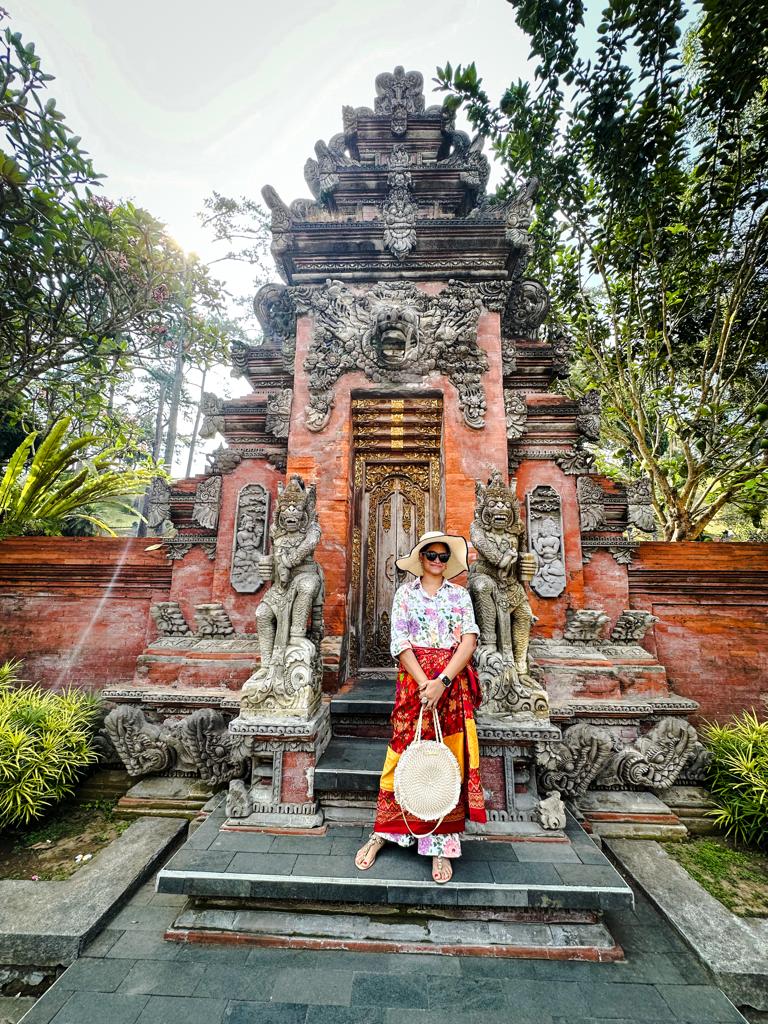
Tips for visiting Tirta Empul
If you like to experience the water purification ceremony at Tirta Empul Temple, it’s important to approach the ritual with respect and cultural sensitivity. Here are some practical tips to help you make the most of your visit:
What to bring for the ceremony:
If you are participating in the ceremony you must bring a hair tie, a pair of inner wears and Towels. Bring CASH for renting the sarongs and lockers.
Appropriate Attire:
Wear a sarong. It’s compulsory to wear a sarong for the water ritual. You can rent one at the temple. This traditional garment shows respect for the sacred nature of the site.
Modest clothing and tie your hair before entering the temple out of respect for the temple’s religious significance.
Maintain a quiet and reverent demeanor: The temple is a place of worship, so it’s important to be mindful of your behavior and refrain from loud conversations or disruptive behavior.
Follow instructions: Listen to any instructions provided by temple staff or local guides to ensure you participate in the ceremony correctly.
Offerings and Donations:
- Bring offerings: Its optional, locals bring big offerings to the temple. If you are up for it you can buy the offerings beforehand and bring it to the temple. There are no shops on the site selling offerings so you have to arrange it beforehand. Offerings can include anything like flowers, fruits, incense, or small gifts to the temple. And leave these at the altars as a sign of gratitude.
2. Make a donation: Consider making a small donation to support the upkeep of the temple and its sacred grounds.
Photography and Respect for Privacy: Well it’s on most of the boards at the temple, to not click pictures but everyone does and we didn’t see anyone having problems because all tourists want pictures here. But I don’t suggest leaving your expensive cameras on the tripode and go for the holy bath. Avoid clicking pictures of kids and womens
Footwear: keep your shoes in the locker before starting the water ritual.
Hygiene and Health: Before entering the water, it’s good if you take shower and ensure you’re clean. Balinese hindu temples also refrain from letting the women during their menstrual cycle.
Follow Local Customs: Observe and follow the lead of locals: If you’re unsure about a particular aspect of the ceremony, observe what others are doing and follow suit.
Open-mindedness and Reverence: Approach the ceremony with an open heart and a spirit of reverence. Be receptive to the spiritual significance of the ritual.
Best time to visit Tirta Empul Temple:
To avoid crowds, you can start your day with the water purification ceremony at the temple, that is early morning 8am. Visit during the early hours will take less time to finish the ceremony.
Nearby Attractions to visit after Tirta Empul Temple:
The area around Tirta Empul Temple is rich in cultural and natural attractions that are worth exploring. Here are some nearby points of interest that visitors might want to consider:
Coffee Plantations Tour: You can add coffee plantation tour with your Tirta Empul Temple tour. There are many coffee plantation tours around Ubud. We went to Bali Pulina coffee plantation.
Gunung Kawi: Located just a short drive away, Gunung Kawi is an ancient temple complex known for its impressive rock-cut shrines. Set amidst lush rice terraces, it has a serene and picturesque setting to explore.
Pura Taman Saraswati (Ubud Water Palace tour): Situated in the heart of Ubud, this temple is dedicated to the goddess Saraswati, the deity of knowledge, arts, and wisdom. The temple’s tranquil lotus pond and beautiful architecture make it a popular spot for visitors.
Tegallalang Rice Terraces: A short drive from Tirta Empul, the Tegallalang Rice Terraces are a stunning example of Bali’s famous rice fields. The terraces offer breathtaking panoramic views and opportunities for leisurely walks.
Goa Gajah (Elephant Cave): Located in Bedulu village, this archaeological site features a historic cave entrance adorned with intricate carvings. The site also includes bathing pools and meditation areas. You can opt for a private temple tours in Bali to visit these temples.
Penglipuran Village: Known as one of Bali’s cleanest and most well-preserved traditional villages, Penglipuran offers a glimpse into authentic Balinese village life. Visitors can explore traditional houses and witness local customs.
Kintamani Volcano and Lake Batur: A short drive from Tirta Empul, Kintamani offers breathtaking views of Mount Batur and its caldera lake. It’s a popular spot for hiking and enjoying the natural beauty of Bali.
Tirta Gangga Water Palace: This royal water garden is located in East Bali and features a series of beautiful pools, fountains, and lush gardens. It’s a serene place to relax and take in the scenic beauty.
Gunung Agung: Bali’s highest and most sacred volcano, Mount Agung, is a prominent feature of the island’s landscape. It holds great spiritual significance for the Balinese people and is often a subject of pilgrimage.
How To Get Around Bali:
For our most tours we always booked Grab taxi. You can download Grab app. It’s an Uber for Southeast Asia.
While in Bali we also observed other way of commute that was renting a scooter to ride yourself. And also can hire a bike by GOJek. It’s an another app from which you can travel single on a bike with a driver. I feel it’s a very option if you can drive or don’t want a stress of learning a way driving in the new country.
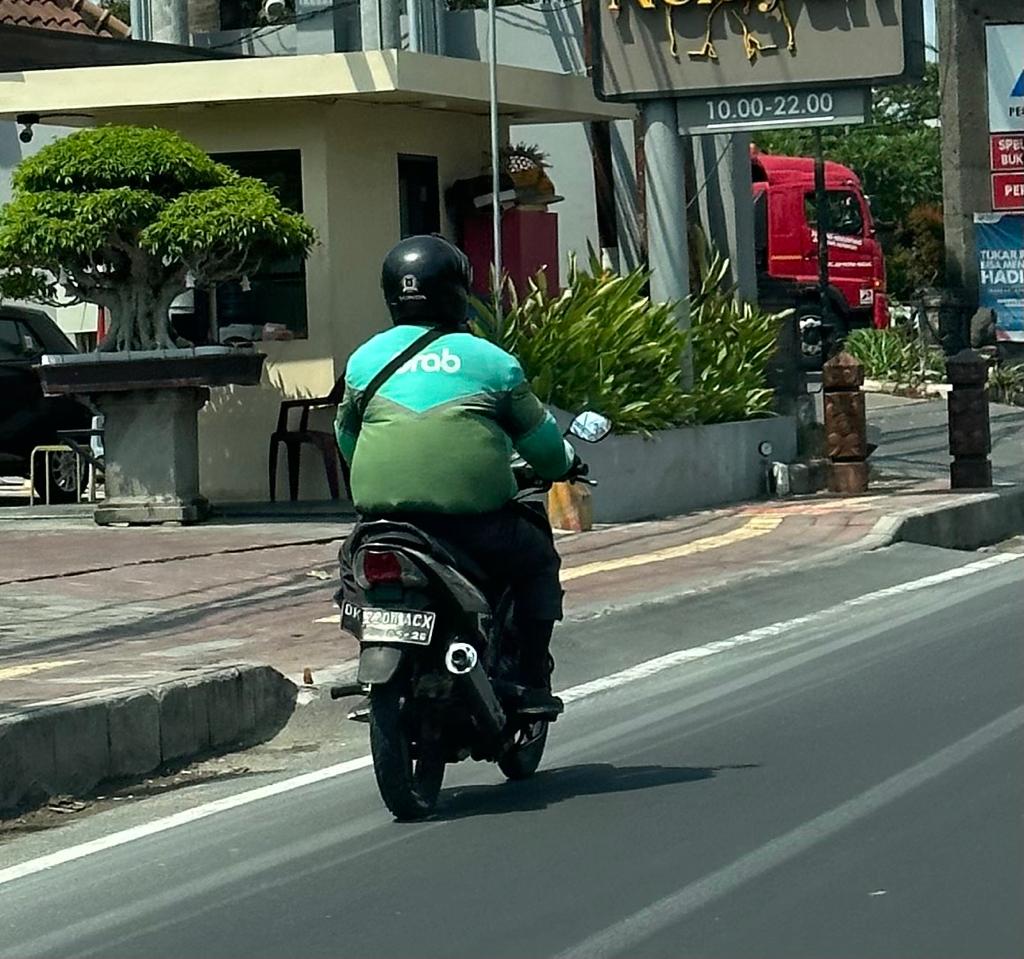
Where To Stay in Bali:
During my research for our vacation in Bali, and after our visit I learned that areas like Kuta, Seminyak and Canggu are very modern, and very developed due to which these areas have heavy traffic in case you need to go around everyday EXPLORING, coming out from these areas are very time taking due to the traffic. We stayed at Fourseasons Bali at Jimbaran Bay for 4 days and in Fourseasons Bali at Sayan, Ubud for 3 days. And we learned while you stay at Jimbaran you can go around visit Kuta, Seminyak, and Canggu and also visit the Uluwatu area or say south Bali. Yes, reaching to these places will also take time but the traffic won’t be too much. To visit the Ubud area and East Bali staying at Ubud is a good idea.
Conclusion:
Tirta Empul Temple provides a well-rounded perspective of Bali’s rich heritage and natural splendor. And I feel after our visit that you must add Tirta Empul Temple tour in your Bali Itinerary.


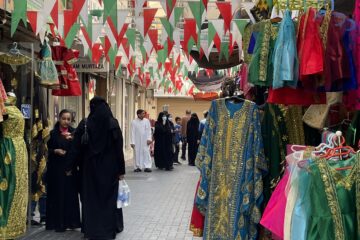
0 Comments